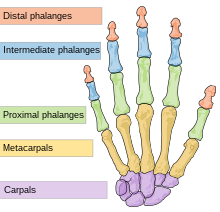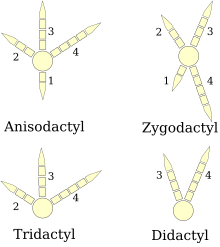Dactyly

In
Sometimes the ending "-dactylia" is used. The derived adjectives end with "-dactyl" or "-dactylous".
As a normal feature
Pentadactyly
Pentadactyly (from
In reptiles, the limbs are pentadactylous.
Dogs and cats have tetradactylous paws but the dewclaw makes them pentadactyls.
Tetradactyly
Tetradactyly (from Greek τετρα tetra "four") is the condition of having four digits on a limb, as in many
Tridactyly

Tridactyly (from Greek τρία tría "three") is the condition of having three digits on a limb, as in the
Didactyly
Didactyly (from Greek δι- di- "two") or bidactyly is the condition of having two digits on each limb, as in the
Monodactyly
Monodactyly (from Greek μόνος monos- "one") is the condition of having a single digit on a limb, as in modern
As a congenital defect
Among humans, the term "five-fingered hand" is sometimes used to mean the abnormality of having five fingers, none of which is a thumb.[citation needed]
Syndactyly

Polydactyly
Polydactyly (from Greek πολυ- poly- "many") is when a limb has more than the usual number of digits. This can be:
- As a result of congenital abnormality in a normally pentadactyl animal. Polydactyly is very common among domestic cats. For more information, see polydactyly.
- ichthyosaurs. The use of a term normally reserved for congenital defects reflects that it was regarded as an anomaly at the time, as it was believed that all modern tetrapods have either five digits or ancestors that did.
Oligodactyly
Oligodactyly (from Greek ὀλιγο- oligo- "few") is having too few digits when not caused by an amputation. It is sometimes incorrectly called hypodactyly or confused with aphalangia, the absence of the phalanx bone on one or (commonly) more digits. When all the digits on a hand or foot are absent, it is referred to as adactyly.[4]
Ectrodactyly
Ectrodactyly, also known as split-hand malformation, is the congenital absence of one or more central digits of the hands and feet. Consequently, it is a form of oligodactyly. News anchor Bree Walker is probably the best-known person with this condition, which affects about one in 91,000 people.[citation needed] It is conspicuously more common in the Vadoma in Zimbabwe.
-
Tetradactyly
-
Tridactyly (Mikhail Tal)
-
Didactyly
-
Monodactyly
Clinodactyly
Clinodactyly is a medical term describing the curvature of a digit (a finger or toe) in the plane of the palm, most commonly the fifth finger (the "little finger") towards the adjacent fourth finger (the "ring finger"). It is a fairly common isolated anomaly which often goes unnoticed, but also occurs in combination with other abnormalities in certain genetic syndromes, such as Down syndrome, Turner syndrome and Cornelia de Lange syndrome.
In birds

(right foot diagrams)
Anisodactyly
Anisodactyly is the most common arrangement of digits in birds, with three toes forward and one back. This is common in
. This arrangement of digits help with perching and/or climbing and clinging. This occurs in and a majority of other birds.Syndactyly
Syndactyly, as it occurs in birds, is like anisodactyly, except that the third and fourth toes (the outer and middle forward-pointing toes), or three toes, are fused together almost to their claws, as in the belted kingfisher (Megaceryle alcyon).[5] This is characteristic of Coraciiformes (kingfishers, bee-eaters, rollers, and relatives).[6]: 37
Zygodactyly
Zygodactyly (from Greek ζυγος, even-numbered) is an arrangement of digits in birds and chameleons, with two toes facing forward (digits 2 and 3) and two back (digits 1 and 4). This arrangement is most common in
Heterodactyly
Heterodactyly is like zygodactyly, except that digits 3 and 4 point forward and digits 1 and 2 point back. This is found only in trogons,[8] though the enantiornithean Dalingheornis might also have had this arrangement.[9]
Pamprodactyly
Pamprodactyly is an arrangement in which all four toes point forward, outer toes (toe 1 and sometimes 4) often if not regularly reversible. It is a characteristic of
Chameleons
The feet of
Aquatic tetrapods
In many secondarily aquatic vertebrates, the non-bony tissues of the forelimbs and/or hindlimbs are fused into a single flipper. Some remnant of each digit generally remains under the soft tissue of the flipper, though digit reduction gradually occurs such as in baleen whales (mysticeti).[11] Marine mammals evolving flippers represents a classic example of convergent evolution, and by some analyses, parallel evolution.[12]
Full webbing of the digits in the
Schizodactyly
Schizodactyly is a primate term for grasping and clinging with the second and third digit, instead of the thumb and second digit.
See also
- Cetartiodactyla
- Perissodactyl– odd-toed ungulates
References
- ^ Stephen Jay Gould. "Stephen Jay Gould "Eight (or Fewer) Little Piggies" 1991". Archived from the original on 2011-08-05. Retrieved 2015-10-02.
- PMID 29410871.
- ISBN 978-0691150611.
- ^
József Zákány; Catherine Fromental-Ramain; Xavier Warot & Denis Duboule (1997). "Regulation of number and size of digits by posterior Hox genes: A dose-dependent mechanism with potential evolutionary implications". PMID 9391088.
- ^ Dudley, Ron (14 February 2016). "Belted Kingfisher With A Fish (plus an interesting foot adaptation)". FeatheredPhotography. Retrieved 4 December 2022.
- ^ ISSN 2305-042X. Retrieved 4 December 2022 – via FitzPatrick Institute of African Ornithology.
- S2CID 15821251.
- PMID 24966313.
- ^ Zhang, Z.; Hou, L.; Hasegawa, Y.; O'Connor, J.; Martin, L.D.; Chiappe, L.M. (2006). "The first Mesozoic heterodactyl bird from China". Acta Geologica Sinica. 80 (5): 631–635.
- ISBN 9780520276055.
- S2CID 14586607.
- PMID 27329977.
- S2CID 28802495.
- PMID 15032905.
External links
- Coates, Michael (25 April 2005). "Why do most species have five digits on their hands and feet?". Scientific American. Retrieved 2009-07-05.




